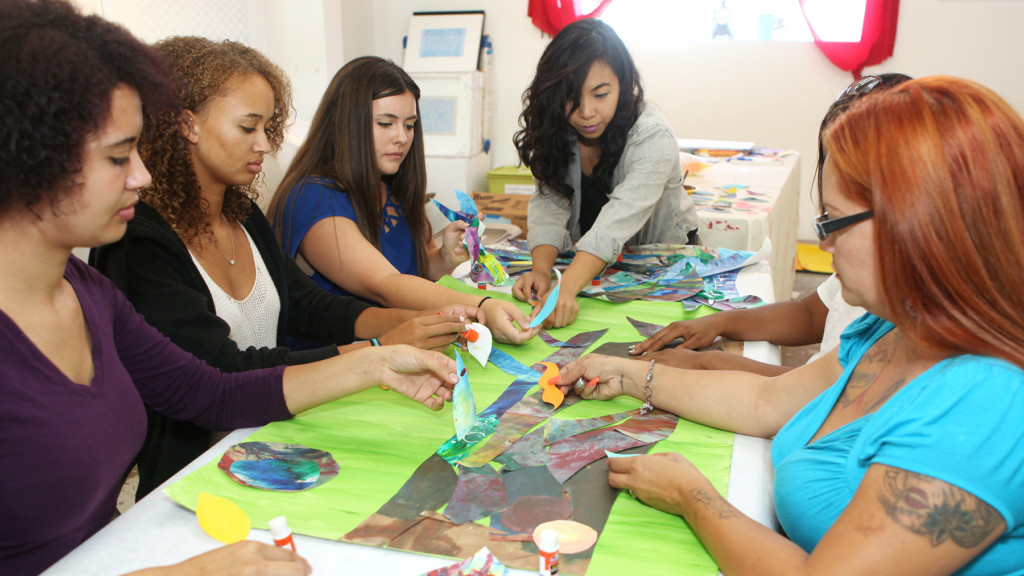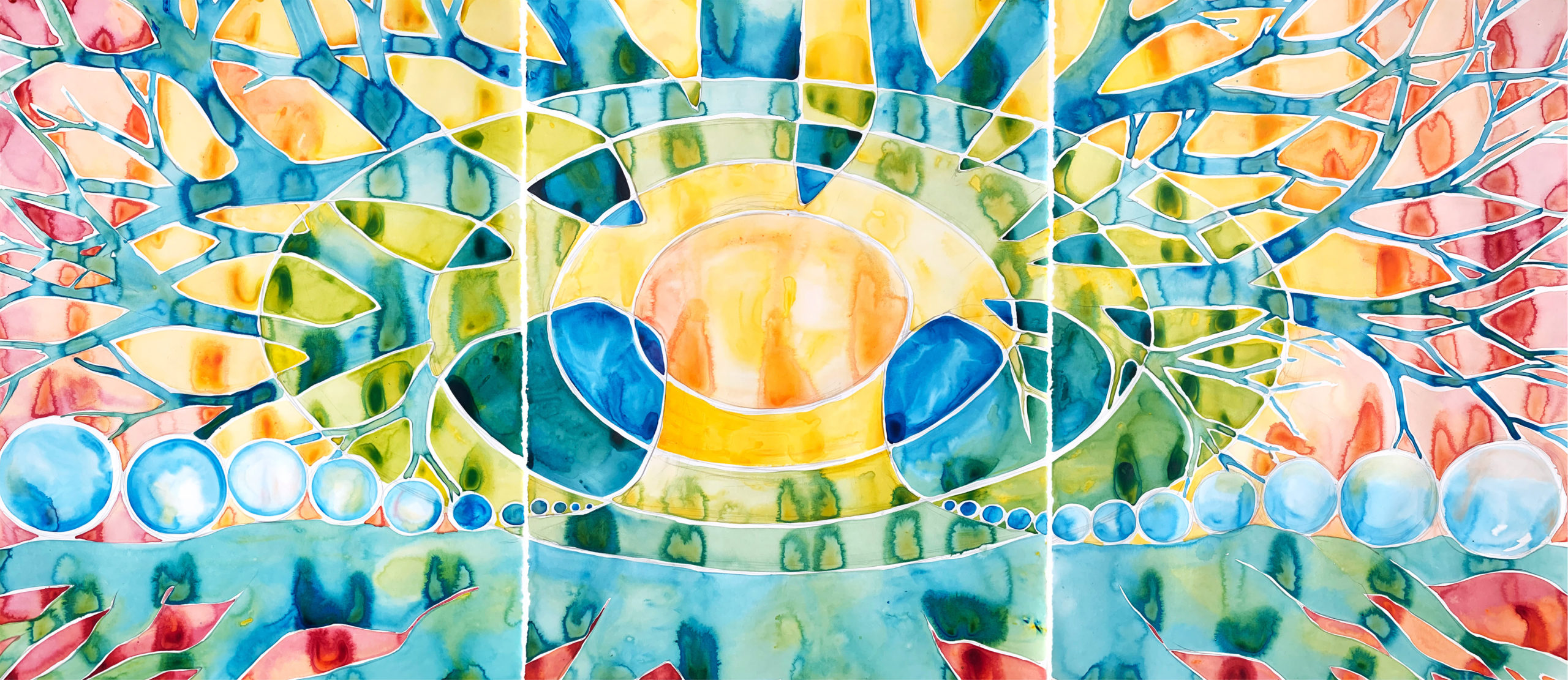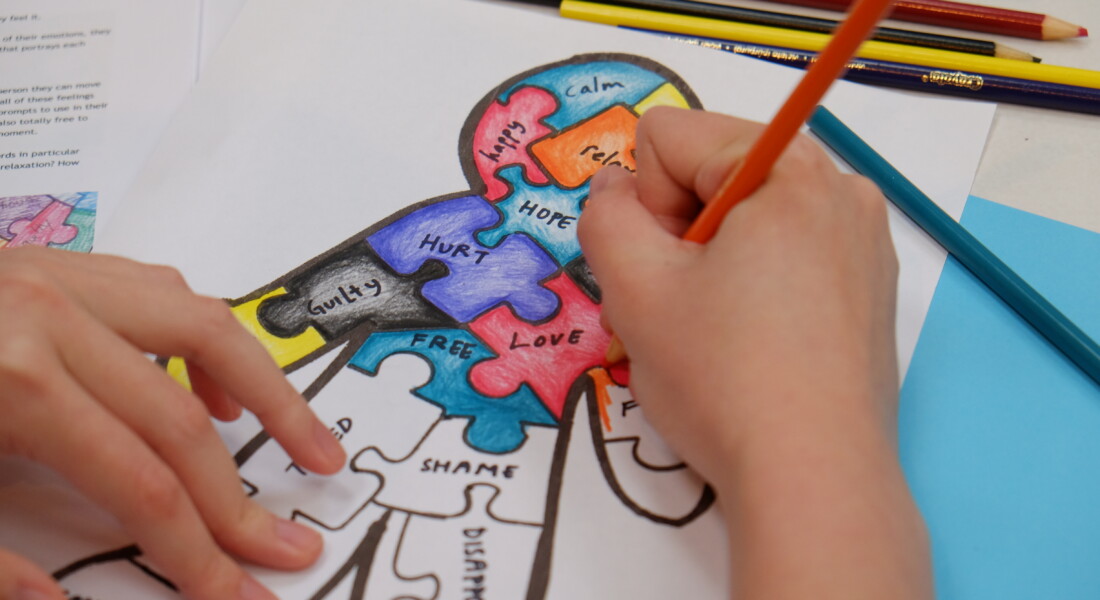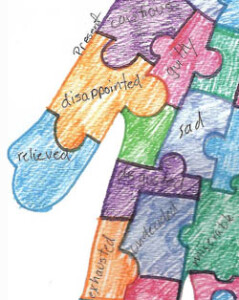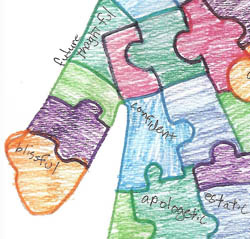There are so many different feelings that we can hold throughout our bodies, especially when we are confronted with stress. We invite you to take some time to identify what you are feeling and express those emotions through this workshop. You can then use your creations as a way to talk and connect with each other.
This is a sample of one of our 600+ workshops in the format it is presented to our trained facilitators. Though this version is written for creating with children, all ages can benefit and are welcome to participate. Join us at a training to gain access to our entire library of workshops.
LEARN MORE ABOUT OUR TRAINING
DOWNLOAD PDF
Objective
This workshop gives children an opportunity to notice the various emotions they are feeling and where they feel these emotions in their body, through writing and coloring those emotions on a person outline made up of puzzle pieces.
This can be an opportunity to help normalize the myriad of emotions youth and children are feeling and give them a way to begin to process them.
Age Range
5 and up
Suggested Materials
• Colored markers
• Colored pencils
• Permanent markers (for writing words)
• Puzzle Pieces Person Template (1 or 2 for each participant)
• Sample Feeling Words Handout
Suggested Timeframe
Introduction: 10 minutes
Warm Up: 10 minutes
Creation: 30 minutes
Closing: 10 minutes
Total Time: 1 hour
Set Up
Before you begin, you might consider laying out blank paper, colored markers, pens, and pencils around the table(s). You may have the templates laid out or you can to hand them out at your own discretion. The choice is yours. You can also have some handouts with the sample feeling words if you’d like.
Depending on the age group and your time constraints, you also have the option to invite children to create two feeling puzzles in one workshop; one to represent their feelings in the present moment and one to represent what they want their feelings to be in the future. This leaves them with an empowered feeling of “putting themselves back together” with the feelings they want to have. Again, this is entirely up to you, but doing only one puzzle piece person will work just as well.
Introduction
“Today, you will have an opportunity to think about the different kinds of feelings and emotions you have and create a special puzzle person that represents all those emotions. Each of us has feelings and emotions. Sometimes emotions makes us feel good or bad, but there are actually no wrong feelings. Sometimes we may feel lots of different things at once; we can feel confused or overwhelmed by not knowing how we really feel. And often times we feel those feelings in certain parts of our body. This is part of being human, and there are ways to learn how to understand our feelings and even get through ones that are difficult and unpleasant.”
“Before we begin, I want you to know that this workshop is a window of time for you. This means that this is a safe space to notice your thoughts, feelings, and needs. Since this space is your window of time, everything you say or do is voluntary. I’ll offer a suggested workshop idea, share about the materials we have available, and invite you to create, but there’s no wrong way to do this. It doesn’t matter what it looks like. What matters is taking this time to truly honor your thoughts and feelings, however they come out. If you can’t think of anything or draw a blank on what to create or write, feel free to just observe. However you choose to spend this time will be perfectly okay. This is your time. Please ask for what you need, and know that I’m here in support of you.”
Demonstration
For demonstration, you may show a sample of a completed puzzle person. This, of course, is only a suggestion. You have complete freedom to proceed as you see fit. If you choose to show a sample, we recommend keeping samples as simple as possible so children don’t feel overwhelmed.
Warm Up
We recommend a warm-up exercise to help create a safe atmosphere for children to explore their emotions. You may use our suggested exercise, or your own. You have complete freedom to adapt and alter any part of this workshop to best suit your group’s needs.
For this exercise, you can invite the children to dance around the room and make a face that they make when they feel a certain emotion. If you wish, you can prompt them with questions like: “What face do you make when you feel happy? Now shake it out.” “What face do you make when you feel sad? Now shake it out.” “What face do you make when you feel angry, tired, excited? Repeat and shake it out.”
Once they’ve had an opportunity to explore their feelings in a fun way, you may invite them to find their seats or a comfortable position and join in a relaxation exercise. You may wish to remind them that every part of this workshop is optional and if they wish to not participate, it’s perfectly okay. Observing is participating.
“For those of you who wish to participate in a relaxation exercise, I’d like to invite you to take a moment and breathe. You can close your eyes, if that feels good to you, or keep your eyes open and focus them on an object in the room. Try to notice your breath as it enters and leaves your body.”
We recommend giving them the opportunity to breathe in and out slowly 3-4 times.
“Now try to see if you feel any feelings in your body. How do you feel right now? Where do you feel that feeling? For example, if you are nervous, does your stomach feel funny or is your heart racing? If you are happy, do you feel it in your face or a tingling in your stomach? Feel free to take a moment and try to notice where your feelings are. As you notice how you feel, try to ask yourself, would that feeling have a certain color? Do different feelings or groups of feelings have different colors or shades? What would that color be? If you can’t identify where in your body you’re feeling, or can’t think of a color that represents that feeling, it’s perfectly okay. Remember, there is no wrong answer and no wrong way to participate.”
Creation
For the creation, you can invite the children to begin by taking a moment to reflect on what feelings and colors came up for them during the warm-up.
Of course, we cannot place a feeling on every part of the puzzle piece. The idea here is that children can explore all the feelings they experience and even if arbitrarily, place it on the puzzle person.
For those who wish to participate, you can then invite them to write a word that describes a feeling that they have right now or even a feeling that they have had sometime today inside each puzzle piece. While words are ideal, they have the option to use a symbol or anything they feel best represents their feelings. You may want to encourage them to notice where in their body they might feel different feelings; they can then write that feeling in the place where they feel it.
After the puzzle pieces are filled with the words of their emotions, you may invite them to color in each puzzle piece with a color that portrays each feeling.
Closing
At the end, you can give the children a chance to share their creation if they wish. For children who chose to create a second feeling puzzle, you may ask if they want to share how it felt to notice the feelings they wish to feel in the future. This can be an empowering process. If they don’t want to share, that is okay.
You may wish to remind them to respect each other’s art and feelings while they share. You may also wish to point out to them how many different feelings and colors there are on everyone’s creation. Even though each creation is different and unique, they all share similar feelings. At the end, you can congratulate them for such wonderful work and for the courage to share their feelings.


